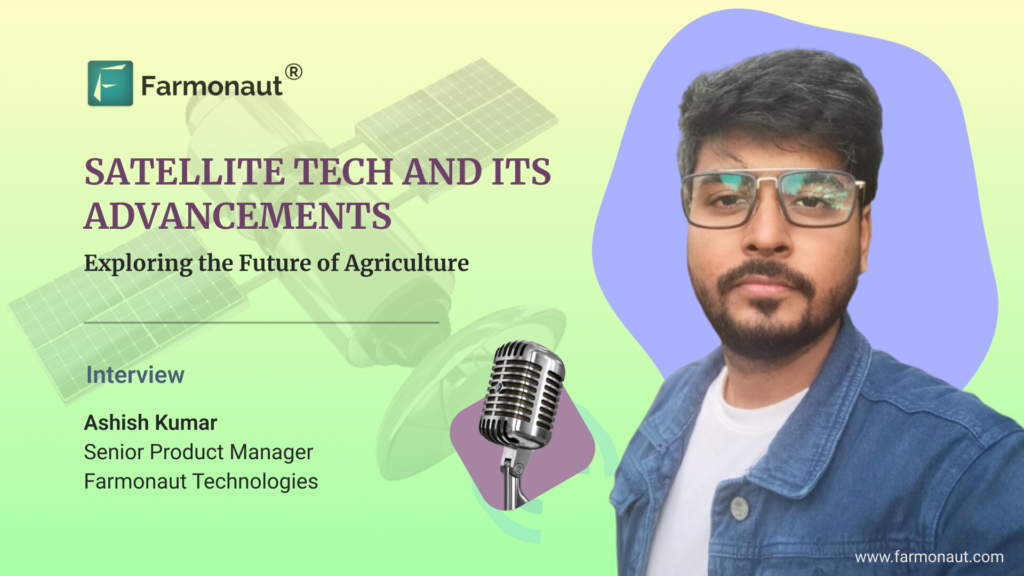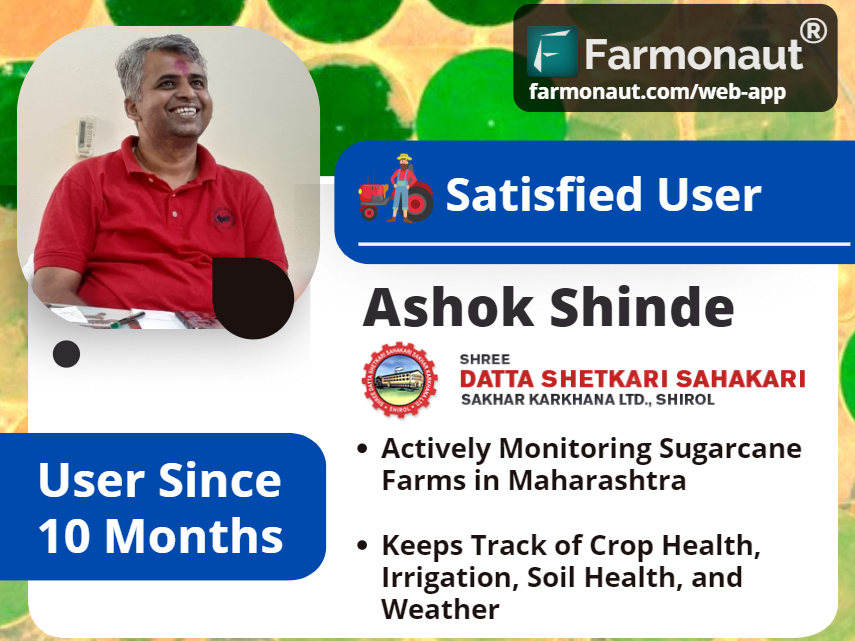
1) Hi Ashish! Can you provide an overview of how satellite technology and remote sensing play a crucial role in modern agriculture? What are some of the key applications?
Certainly! Satellite technology and remote sensing have truly revolutionized modern agriculture. Imagine satellites acting as vigilant custodians, providing a bird’s-eye view of farms and their intricate ecosystems. These high-tech orbiters equipped with an array of sensors capture invaluable data, ranging from crop health and growth patterns to soil composition and moisture levels. This data is the bedrock of informed decision-making for farmers, enabling them to optimize irrigation schedules, tailor fertilizer usage, detect pest infestations, forecast yields, and essentially fine-tune their farming strategies for maximum productivity and sustainability.
2) Farmonaut has been actively involved in agricultural remote sensing. Could you share some insights into the types of satellite sensors you utilize to gather data for agricultural purposes?
Absolutely! At Farmonaut, we harness the power of sophisticated satellite sensors, meticulously designed for the agricultural domain. Our toolkit includes multispectral and hyperspectral sensors, which act as the eyes of the satellites, capturing a diverse range of wavelengths. Multispectral sensors give us a glimpse into vital factors such as chlorophyll content, crop stress, and vegetation health, whereas hyperspectral sensors provide an even more detailed view, enabling precise analysis of nutrient levels, soil composition, and overall crop vitality. This wealth of information is the cornerstone of our data-driven approach.
3) Continuing from that different satellites offer various resolutions for remote sensing. How does Farmonaut select the appropriate satellite and resolution for specific agricultural tasks, and how does this impact the accuracy of the data collected?
Tailoring our approach to match the specific needs of agricultural tasks is pivotal. Farmonaut meticulously evaluates the scope and requirements of each task. For tasks demanding intricate details, we opt for satellites boasting high resolutions, capturing data with remarkable granularity. Conversely, when broader coverage is essential for regional assessments, we select satellites with a wider field of view. This strategic selection directly influences the precision and fidelity of the data we collect, ensuring that it aligns perfectly with the intended purpose and provides farmers with the most actionable insights.
4) Could you highlight some of the challenges and limitations associated with using satellite technology in agriculture, and how Farmonaut addresses or mitigates these issues?
Absolutely. While satellite technology offers immense potential, it’s not devoid of challenges. Cloud cover, a perpetual nemesis, often obscures our view from space. This interference can hinder data collection. However, Farmonaut has honed advanced data processing algorithms adept at minimizing the impact of cloud cover and thus provide RVI (Radar Vegetation Index) & RSM (Radar Soil Moisture) to cater the could cover. Moreover, the sporadic revisit frequency of satellites can pose a challenge, but we optimize data acquisition strategies to mitigate this limitation and ensure a consistent stream of valuable data. We’re constantly fine-tuning our methods to efficiently address these challenges and deliver robust solutions to our users.
5) Precision agriculture relies heavily on data analysis. Can you explain how Farmonaut processes and interprets the data collected from satellites and sensors to provide actionable insights to farmers?
Certainly. The treasure trove of data collected undergoes a meticulous journey within Farmonaut. Our highly skilled team utilizes advanced data analytics and cutting-edge machine learning algorithms to process and interpret the data. Image classification techniques help identify different crops and their health statuses. Anomaly detection algorithms pinpoint irregularities like pest infestations. Trend analysis algorithms provide valuable insights into growth patterns and potential yield. By translating raw data into meaningful insights through these analytical processes, we empower farmers to make informed decisions on crop planning, disease management, irrigation schedules, and yield prediction. Also, All of the process is automated which makes our technology highly scalable.
6) Are there any recent advancements or innovations in satellite technology that Farmonaut is particularly excited about and plans to integrate into its services for farmers?
Absolutely, there’s a wave of excitement regarding recent advancements in satellite constellations. The emergence of constellations enhances our capabilities for real-time monitoring and substantially improves revisit frequencies. This means we can offer farmers even more timely and accurate insights into their farms. We’re actively planning to integrate data from these constellations, further enhancing our services and bolstering our commitment to providing farmers with the best possible support.
7) Farmonaut aims to improve crop monitoring and management. Can you share some success stories or real-world examples of how your technology has positively impacted farmers' decision-making and crop yields?
Certainly! Let me introduce you to Mr. Ashok Shinde, a sugarcane farmer in Maharashtra. Mr. Shinde used Farmonaut to tackle irrigation challenges, relying on data like NDMI, NDWI, and evapotranspiration. This data helped optimize his irrigation strategies, boosting yields.
Apart from irrigation, our reports gave insights into crop health, temperature, pests, and diseases. Mr. Shinde faced issues of leaching and declining yields due to soil organic carbon shortage, which he addressed using organic fertilizers. He aims to share these techniques with fellow farmers for collective progress.
Mr. Shinde’s proactive engagement with our technology showcases its value. Using our services for about ten months, he appreciates the depth of insights we provide, underlining the positive impact on farmers’ decision-making and yields.

